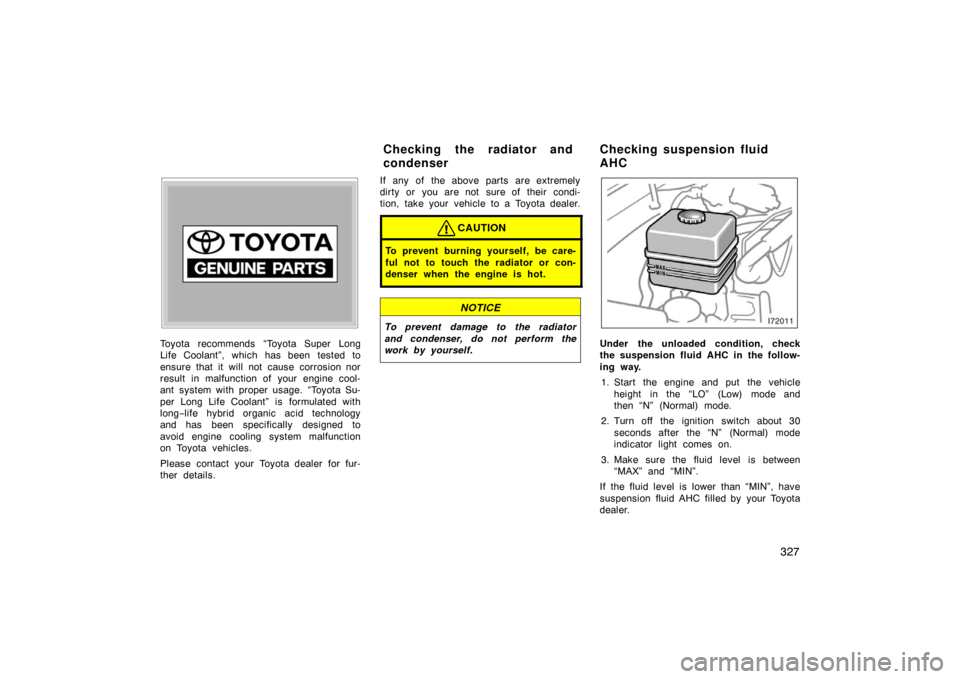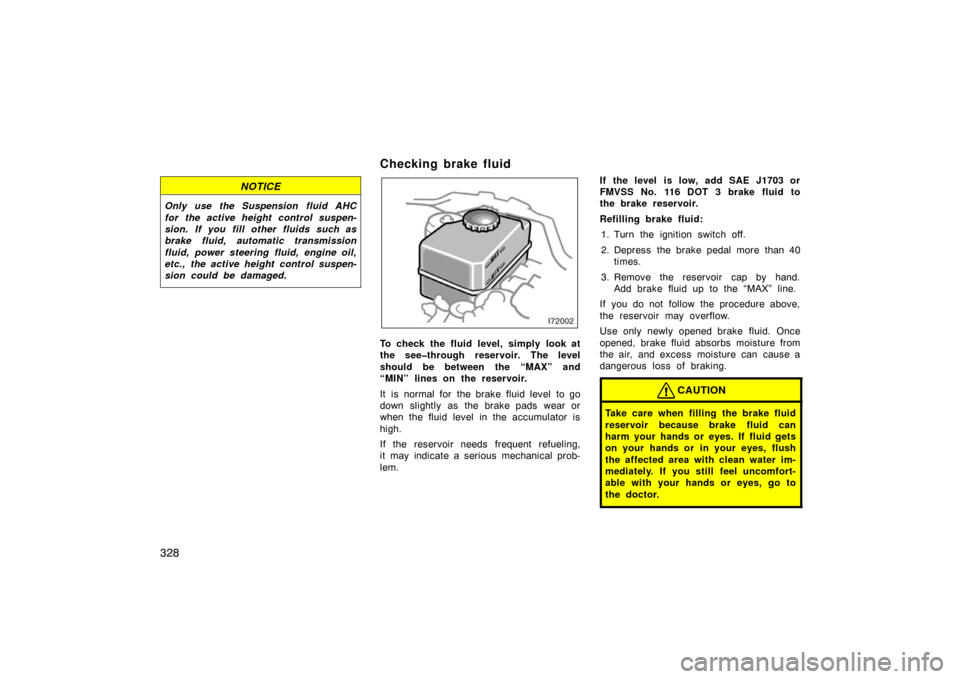Page 341 of 374

327
Toyota recommends “Toyota Super Long
Life Coolant”, which has been tested to
ensure that it will not cause corrosion nor
result in malfunction of your engine cool-
ant system with proper usage. “Toyota Su-
per Long Life Coolant” is formulated with
long−life hybrid organic acid technology
and has been specifically designed to
avoid engine cooling system malfunction
on Toyota vehicles.
Please contact your Toyota dealer for fur-
ther details. If any of the above parts are extremely
dirty or you are not sure of their condi-
tion, take your vehicle to a Toyota dealer.
CAUTION
To prevent burning yourself, be care-
ful not to touch the radiator or con-
denser when the engine is hot.
NOTICE
To prevent damage to the radiator
and condenser, do not perform the
work by yourself.
Under the unloaded condition, check
the suspension fluid AHC in the follow-
ing way.
1. Start the engine and put the vehicle height in the “LO” (Low) mode and
then “N” (Normal) mode.
2. Turn off the ignition switch about 30 seconds after the “N” (Normal) mode
indicator light comes on.
3. Make sure the fluid level is between “MAX” and “MIN”.
If the fluid level is lower than “MIN”, have
suspension fluid AHC filled by your Toyota
dealer.
Checking the radiator and
condenser Checking suspension fluid
AHC
Page 342 of 374

328
NOTICE
Only use the Suspension fluid AHC
for the active height control suspen-
sion. If you fill other fluids such as
brake fluid, automatic transmission
fluid, power steering fluid, engine oil,
etc., the active height control suspen-
sion could be damaged.
Checking brake fluid
To check the fluid level, simply look at
the see�through reservoir. The level
should be between the “MAX” and
“MIN” lines on the reservoir.
It is normal for the brake fluid level to go
down slightly as the brake pads wear or
when the fluid level in the accumulator is
high.
If the reservoir needs frequent refueling,
it may indicate a serious mechanical prob-
lem.If the level is low, add SAE J1703 or
FMVSS No. 116 DOT 3 brake fluid to
the brake reservoir.
Refilling brake fluid:
1. Turn the ignition switch off.
2. Depress the brake pedal more than 40 times.
3. Remove the reservoir cap by hand. Add brake fluid up to the “MAX” line.
If you do not follow the procedure above,
the reservoir may overflow.
Use only newly opened brake fluid. Once
opened, brake fluid absorbs moisture from
the air, and excess moisture can cause a
dangerous loss of braking.
CAUTION
Take care when filling the brake fluid
reservoir because brake fluid can
harm your hands or eyes. If fluid gets
on your hands or in your eyes, flush
the affected area with clean water im-
mediately. If you still feel uncomfort-
able with your hands or eyes, go to
the doctor.
Page 351 of 374

337
NOTICE
If the wrong combination of tire and
chain is used, the chains could dam-
age the vehicle body.
CHAIN INSTALLATION
Install the chains on the rear tires as
tightly as possible. Do not use tire
chains on the front tires. Retighten
chains after driving 0.5 – 1.0 km (1/4 –
1/2 mile).
When installing chains on your tires, care-
fully follow the instructions of the chain
manufacturer.
If wheel covers are used, they will be
scratched by the chain band, so remove
the covers before putting on the chains.
CAUTION
�Do not exceed 50 km/h (30 mph) or
the chain manufacturer ’s recom-
mended speed limit, whichever is
lower.
�Drive carefully avoiding bumps,
holes, and sharp turns, which may
cause the vehicle to bounce.
�Avoid sharp turns or locked�wheel
braking, as use of chains may ad-
versely affect vehicle handling.
�When driving with chains installed,
be sure to drive carefully. Slow
down before entering curves to
avoid losing control of the vehicle.
Otherwise an accident may occur.
Replacing wheels
WHEN TO REPLACE YOUR WHEELS
If you have wheel damage such as
bending, cracks or heavy corrosion, the
wheel should be replaced.
If you fail to replace a damaged wheel,
the tire may slip off the wheel or cause
loss of handling control.
WHEEL SELECTION
When replacing wheels, care should be
taken to ensure that the wheels are re-
placed by ones with the same load ca-
pacity, diameter, rim width, and offset.
Correct replacement wheels are available
at your Toyota dealer.
A wheel of a different size or type may
adversely affect handling, wheel and bear-
ing life, brake cooling, speedometer/odom-
eter calibration, stopping ability, headlight
aim, bumper height, vehicle ground clear-
ance, and tire or snow chain clearance to
the body and chassis.
Page 364 of 374
350
Dimensions and weights
Overall length mm (in.) 4890 (192.5)
Overall width mm (in.) 1940 (76.4)
Overall height
∗1mm (in.) 1875 (73.8)
1850 (72.8)∗2
Wheelbase mm (in.) 2850 (112.2)
Front tread mm (in.) 1620 (63.8)
Rear tread mm (in.) 1615 (63.6)
Vehicle capacity weight
(occupants + luggage)
kg (lb.) 545 (1200)
Towing capacity
(trailer weight + cargo weight) kg (lb.) 2948 (6500)
∗1: Unladen vehicle
∗2: With active height control suspension
Engine
Model:
4.7L V8 (2UZ −FE)
Type: 8 cylinder V type, 4 cycle, gasoline
Bore and stroke, mm (in.): 94.0 � 84.0 (3.70 � 3.30)
Displacement, cm
3 (cu. in.):
4664 (284.6)
Fuel
Fuel type: Unleaded gasoline, Octane Rating 87
(Research Octane Number 91) or higher.
Fuel tank capacity, L (gal., Imp.gal.): 96 (25.4, 21.1)
Page 370 of 374

356
81C506
Engine compartment
26. HEAD (LH�LWR) 10 A: Left−hand head-
light (low beam)
27. HEAD (RH�UPR) 20 A: Right −hand
headlight (high beam)
28. HEAD (LH�UPR) 20 A: Left −hand head-
light (high beam)
29. PWR OUTLET 15 A: Power outlets
30. CIG 15 A: Cigarette lighter
31. ACC 7.5 A: Instrument panel light
32. AM1 7.5 A: Multiport fuel injection sys-
tem/Sequential multiport fuel injection
system
33. DEFOG 20 A:
Rear window defogger
34. AHC�B 15 A: Active height control sus-
pension (AHC)
35. FUEL HTR 20 A: Fuel heater
36. POWER HTR 7.5 A: Power heater
37. AHC�IG 20 A: Active height control sus-
pension (AHC)
38. EFI or ECD No.2 10 A: Emission con-
trol system
39. GAUGE1 10 A: Gauges and meters
40. ECU�IG1 10 A: Multiport fuel injection
system/S equential multiport fuel injec-
tion system
41. ECU�B1 10 A:
Navigation system
42. DBL LOCK 15 A: Double lock system
43. A/C 15 A: Air conditioning system
44. STOP 15 A: Stop lights
45. OBD�2 7.5 A: On −board diagnosis sys-
tem
46. IDEL UP 7.5 A: Idle −up system
47. LH SEAT 30 A: Power seat system
48. DOOR 25 A: Power door lock system,
Power windows
49. SUN ROOF 25 A: Electronic moon roof
50. RR WIPER 15 A: Rear wiper system
51.ECU�B2 10 A: Power door lock system,
Power window
52. DIFF 20 A: Four−wheel drive system
53. WASHER 15 A: Windshield washer
54. RADIO 10 A: Audio system
55. DOME 10 A: Interior lights
56. VGRS 40 A: Variable gear ratio steer-
ing system
57. P/W (FL) 20 A: Power window
58. P/W (RL) 20 A: Power window
59. WIPER 25 A: Windshield wiper
60. ECU�IG2 10 A: Rear air conditioning
system
61. SEAT HTR 15 A: Seat heater
62. GAUGE2 10 A: Back−up lights
63. MET 7.5 A: Gauges and meters
64. IGN 7.5 A: Multiport fuel injection sys-
tem/Sequential multiport fuel injection
system
65. SECURITY 7.5 A: Theft deterrent sys-
tem
66. P/W (RR) 20 A: Power window
67. P/W (FR) 20 A: Power window
68. BATT CHARGE 30 A: Trailer charging
system
69. TIL&TEL 20 A: Tilt and telescopic
steering